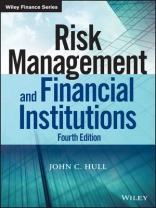The most complete, up to date guide to risk management infinance
Risk Management and Financial Institutions explains allaspects of financial risk and financial institution regulation, helping readers better understand the financial markets andpotential dangers. This new fourth edition has been updated toreflect the major developments in the industry, including thefinalization of Basel III, the fundamental review of the tradingbook, SEFs, CCPs, and the new rules affecting derivatives markets.There are new chapters on enterprise risk management and scenarioanalysis. Readers learn the different types of risk, how and wherethey appear in different types of institutions, and how theregulatory structure of each institution affects risk managementpractices. Comprehensive ancillary materials include software, practice questions, and all necessary teaching supplements, facilitating more complete understanding and providing an ultimatelearning resource.
All financial professionals need a thorough background in riskand the interlacing connections between financial institutions tobetter understand the market, defend against systemic dangers, andperform their jobs. This book provides a complete picture of therisk management industry and practice, with the most up to dateinformation.
* Understand how risk affects different types of financialinstitutions
* Learn the different types of risk and how they are managed
* Study the most current regulatory issues that deal withrisk
Risk management is paramount with the dangers inherent in thefinancial system, and a deep understanding is essential for anyoneworking in the finance industry; today, risk management is part ofeveryone’s job. For complete information and comprehensivecoverage of the latest industry issues and practices, Risk Management and Financial Institutions is an informative, authoritative guide.
สารบัญ
Business Snapshots xxi
Preface xxiii
Chapter 1: Introduction 1
PART ONE : FINANCIAL INSTITUTIONS AND THEIR TRADING
Chapter 2: Banks 25
Chapter 3: Insurance Companies and Pension Plans 45
Chapter 4: Mutual Funds and Hedge Funds 71
Chapter 5: Trading in Financial Markets 93
Chapter 6: The Credit Crisis of 2007 121
Chapter 7: Valuation and Scenario Analysis: The Risk-Neutral and Real Worlds 137
PART TWO : MARKET RISK
Chapter 8: How Traders Manage Their Risks 153
Chapter 9: Interest Rate Risk 175
Chapter 10: Volatility 201
Chapter 11: Correlations and Copulas 231
Chapter 12: Value at Risk and Expected Shortfall 255
Chapter 13: Historical Simulation and Extreme Value Theory 277
Chapter 14: Model-Building Approach 299
PART THREE : REGULATION
Chapter 15: Basel I, Basel II, and Solvency II 325
Chapter 16: Basel II.5, Basel III, and Other Post-Crisis Changes 353
Chapter 17: Fundamental Review of the Trading Book 373
PART FOUR : CREDIT RISK
Chapter 18: Managing Credit Risk: Margin, OTC Markets, and CCPs 383
Chapter 19: Estimating Default Probabilities 401
Chapter 20: CVA and DVA 429
Chapter 21: Credit Value at Risk 447
PART FIVE : OTHER TOPICS
Chapter 22: Scenario Analysis and Stress Testing 463
Chapter 23: Operational Risk 481
Chapter 24: Liquidity Risk 501
Chapter 25: Model Risk 527
Chapter 26: Economic Capital and RAROC 547
Chapter 27: Enterprise Risk Management 565
Chapter 28: Risk Management Mistakes to Avoid 579
PART SIX : APPENDICES
Appendices 591
Answers to Questions and Problems 629
Glossary 669
Deriva Gem Software 689
Tables for N(x) 695
Index 699
เกี่ยวกับผู้แต่ง
JOHN C. HULLis the Maple Financial Professor of Derivatives and Risk Management at the Joseph L. Rotman School of Management, University of Toronto, and codirector of Rotman’s Master of Finance program. He has been a consultant to many North American, Japanese, and European fi nancial institutions, and is the author of three books, which are widely used by both practitioners and academics, and an associate editor of eight academic journals.












